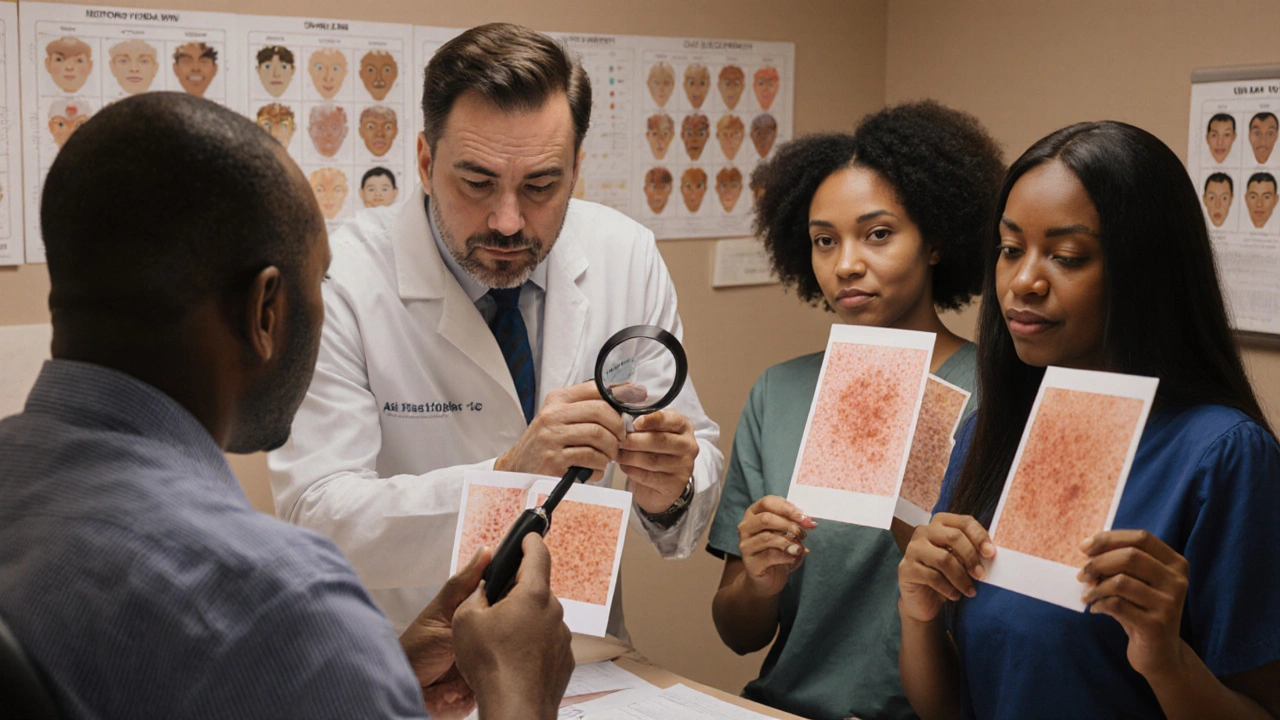Eczema vs. Psoriasis: How to Tell Them Apart by Rash Appearance
 Nov, 26 2025
Nov, 26 2025
Two skin conditions that look almost identical at first glance-eczema and psoriasis-are often mixed up, even by doctors. Both cause red, itchy, flaky patches. But they’re not the same. Mistaking one for the other can mean using the wrong treatment, wasting time, and making symptoms worse. The key isn’t just how they feel-it’s how they look.
Where the Rash Shows Up Tells You Everything
If you want to tell eczema and psoriasis apart, start by looking at where the rash is. Eczema loves the bends. You’ll find it on the inside of your elbows, behind your knees, on your wrists, ankles, and the folds of your neck. In babies, it’s common on the cheeks and scalp. This pattern isn’t random-it’s tied to how the immune system reacts to irritants in skin creases. Psoriasis, on the other hand, prefers the outside. Think elbows, knees, scalp, lower back, and even fingernails. It doesn’t hide in the folds-it shows up on the bony parts. A simple rule: eczema inside the creases, psoriasis outside. That’s the first clue dermatologists use before even touching the skin.The Texture: Oozing vs. Armor Plating
Eczema skin often looks wet. In its active phase, it can weep, crust, or even bleed from scratching. The edges are blurry-like a watercolor painting that’s run. The redness fades into normal skin without a clear border. In chronic cases, the skin gets thick and leathery from constant rubbing, but it never forms the hard, raised plates you see with psoriasis. Psoriasis is the opposite. It’s dry, thick, and stubborn. The patches are raised, with clear, sharp borders that stand out like they’ve been drawn with a marker. The surface is covered in thick, silvery-white scales. These aren’t flaky like dry skin-they’re like tiny tiles stuck to the skin. When you scrape them off, you might see tiny dots of blood underneath. That’s called the Auspitz sign, and it’s almost never seen in eczema.Color Changes on Darker Skin
Most textbooks show eczema and psoriasis on light skin. But that’s not the full picture. On medium to dark skin tones, both conditions look very different. Eczema doesn’t always look red. It can appear as ashen, gray, or purplish patches. The scaling is subtle, often missed because there’s no bright red inflammation. People with darker skin are more likely to have patches that are darker or lighter than their normal skin tone-this is called post-inflammatory pigmentation. Psoriasis on darker skin looks like deep violet, brown, or gray plaques. The silvery scales are still there, but they might be finer and harder to spot. One key sign: a pale ring around the edge of the patch. This “halo” effect shows up in nearly 70% of cases on darker skin and is rarely seen in eczema. A 2021 study found that dermatologists misdiagnose eczema and psoriasis on darker skin 35% more often than on lighter skin. That’s not because patients are different-it’s because medical training hasn’t kept up.
Nails: A Hidden Clue
Look at your fingernails. If you see small pits, like pinpricks, or if your nail is lifting from the nail bed, it’s almost certainly psoriasis. About half of people with psoriasis have nail changes. This happens because psoriasis attacks the nail matrix-the part under the cuticle where the nail grows. Eczema rarely affects nails. If it does, you might see ridges or discoloration, but never true pitting or separation. Nail changes are one of the most reliable signs that what you’re dealing with is psoriasis, not eczema.How the Skin Reacts to Injury
Here’s a trick most people don’t know: if you scratch, scrape, or burn your skin, and new patches appear right where the injury happened, it’s likely psoriasis. This is called the Koebner phenomenon. It happens in about one in three people with psoriasis. In eczema, it’s rare. If you’ve ever had a rash show up after a bug bite, a sunburn, or even a tight bracelet, and it stayed exactly where the trauma happened, that’s a strong clue. It doesn’t mean you have psoriasis for sure-but it’s worth mentioning to your doctor.What the Patients Say
Real people describe these conditions in ways that match the science. On patient forums, eczema users say things like, “My skin feels raw, like it’s been scraped,” or “It cracks and bleeds when I move.” Psoriasis users say, “It looks like armor,” or “The scales won’t come off no matter how much I moisturize.” One Reddit user with psoriasis wrote: “I used to wear long sleeves in summer just to hide it. People thought I was dirty.” Another with eczema said: “I didn’t want to hold my baby because I was afraid my skin would stick to theirs.” These aren’t just descriptions-they’re emotional truths tied to how the skin looks and behaves.

Tom Shepherd
November 27, 2025 AT 15:50Also the nail thing? Yeah mine got pitted and no one ever connected it to psoriasis until years later.
Gayle Jenkins
November 28, 2025 AT 03:51Also the Koebner phenomenon? I got a rash after a tattoo and thought it was an infection. Turns out it was my body being dramatic.
Kaleigh Scroger
November 28, 2025 AT 12:43Allison Turner
November 28, 2025 AT 14:52Alex Hess
November 28, 2025 AT 22:03Leo Adi
November 30, 2025 AT 04:34Aishwarya Sivaraj
November 30, 2025 AT 06:27Darrel Smith
December 2, 2025 AT 05:43Iives Perl
December 2, 2025 AT 18:12